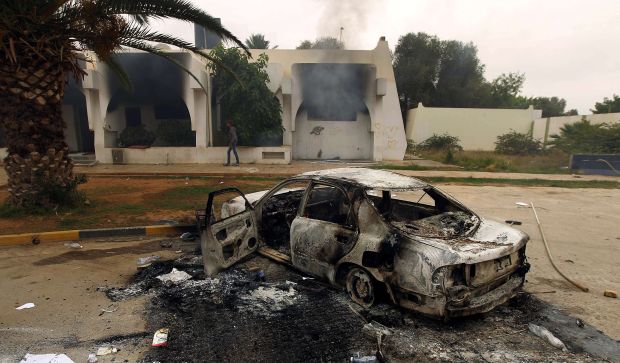
The wreckage of a burnt car is seen outside a building used by Ansar al-Sharia militia after it was torched by residents on November 25, 2013 in Benghazi. (AFP/Abdullah Doma)
Cairo, Asharq Al-Awsat—The Ansar Al-Sharia militia is reported to have withdrawn from Benghazi following clashes with the Libyan army on Monday that left at least nine people dead.
“Nine people were killed and 49 injured,” acting Libyan Interior Minister Sadiq Abdulkarim announced on Monday. Casualties were reported among both the army and Ansar Al-Sharia militia.
Monday’s clashes represent the first overt clashes between the Libyan army and the Islamist militia, whose influence in Benghazi is on the rise. Ansar Al-Sharia have been implicated in the 2012 attack on the US consulate in Benghazi and the death of US Ambassador Christopher Stevens, who died in that attack.
The Libyan military issued an emergency mobilization, calling on all troops on leave the area to return to their units. The army also issued a statement calling on the people of Benghazi to remain calm and stay indoors.
Libyan security official Ibrahim Al-Awami said that the army had taken complete control over Benghazi, a traditional stronghold of armed militias.
Speaking to Asharq Al-Awsat on Monday, Awami said: “Benghazi has previous experience with situations such as this. The clashes are currently on the decline.There are very intermittent clashes.”
He added: “The militia [Ansar Al-Sharia] the army was confronting has now left the city.”
When asked about reports that the Operations Room of Libya’s Revolutionaries (ORLR)—the group which abducted Prime Minister Ali Zeidan last month—had fought alongside Ansar Al-Sharia, Awami said: “This is what makes the army and police stand out—you can tell who they are from their uniforms. But you cannot identify those who are in militias.”
Awami warned that any military convoy attempting to leave or enter Benghazi without the permission of the military would be viewed as an illegal militia and attacked.
In a statement on Monday, the Libyan Interior Ministry announced that it has placed its capabilities at the disposal of the Libyan Special Forces tasked with securing and protecting Benghazi.
Meanwhile, Prime Minister Ali Zeidan warned that attacking the Libyan Army is a “red line that must not be crossed.”
The interim government said that the deteriorating security situation in the city demonstrates the need to accelerate the implementation of the ban on armed militias entering the city.
Ansar Al-Sharia was formed in Benghazi following the fall of the Gaddafi regime in October 2011. The radical Islamist group, which calls for the establishment of an Islamic state in Libya, soon became active across the country, including in Misrata, Sirte and Derna.
The latest violence in Benghazi comes following similar clashes between armed militias and government forces in Tripoli last week.
Tripoli residents have been photographed brandishing pastries—especially a croissant-like brioche called baryoosh—on the streets this week as a symbol of their victory following the militias’ withdrawal from the capital. This has been described as a response to the city’s inhabitants being disparaged by outsiders as “baryoosh-eating Tripolitans” who had been liberated from Gaddafi rule by militias from other cities.

Trackbacks/Pingbacks